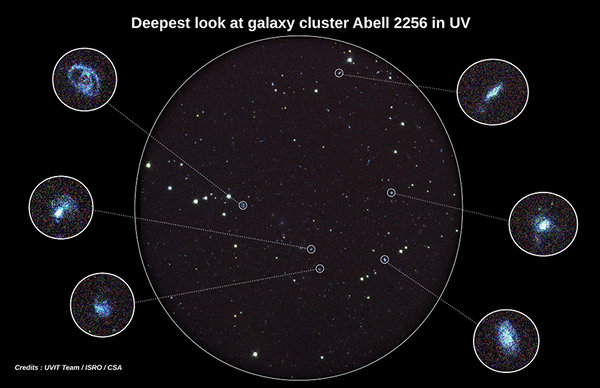The countless stars we see in the night sky with our naked eye belong to our Milky Way Galaxy. The Milky Way is a spiral galaxy where stars are being born from the dense molecular gas clouds in the spiral arms. There are mainly two types of galaxies in the Universe, spiral galaxies, blue in color with active star formation in spiral arms and elliptical galaxies, red in color, with no current star formation, hosting old, red stars in elliptical orbits. The elliptical galaxies are mostly found in the centers of massive galaxy clusters, 100 -to- 1000 galaxies bound together by gravity and which are the massive structures in the Universe. Why are galaxy clusters rich in red and dead elliptical galaxies and not star forming spiral galaxies? This is one of the question we want to answer using Ultra Violet Imaging Telescope (UVIT) onboard ASTROSAT.
Galaxy clusters which are still forming from small groups of galaxies are ideal laboratories to study the galaxy evolution. The current understanding is that spiral galaxies fall in to a cluster, get stripped of the cold molecular gas (which is the fuel for star formation), undergoes tidal interaction with other galaxies and finally gets transformed to red and dead elliptical galaxy. But before getting completely transformed the galaxy goes through a final phase of vigorous star formation, much like a candle showing a final brightening before it extinguishes. The newly formed massive stars emit the bulk of the light in the ultraviolet wavelength region and can be easily distinguished from old stars which emits mostly in optical/IR wavelengths. Thus observing in ultraviolet can help us in understanding the final phase of star formation in galaxies falling in to merging galaxy clusters.
The UVIT is having an angular resolution of 1.2 arc second in near UV, which means we can distinguish objects emitting UV separated by ~ 2km at the distance of moon. This is a unique feature of UVIT which previous dedicated UV missions like GALEX (NASA) does not have (GALEX angular resolution is 3-4 arc second). The field of view of UVIT is 28.5 arcminute diameter or very close to the angular size of moon. Also UVIT has multiple filter bands using which we can take images in different ultraviolet wavelengths. This is much like taking the UV photo of the Universe in different colors.
On December 29th, 2015 we pointed the UVIT telescope to the direction of Abell 2256 galaxy cluster. Abell 2256 is a merging galaxy cluster in which many spiral galaxies are believed to be transforming in to elliptical galaxies. The galaxy cluster was studied extensively in optical, radio and X-rays, but not in ultraviolet. The radiation from the galaxies in the cluster located at a distance of 250 Mpc takes about billion years to reach Earth. UVIT collected ultraviolet light emitted one billion year ago from the galaxies in three narrow-band filters in the near UV wavelength region (200-320 nm).

The color composite is created using three narrow band filters with an exposure time of 5 hours. This is the deepest UV observation of this galaxy cluster. Blue objects highlighted in circular region of diameter ~ 40 kpc are star forming galaxies in the cluster. Thanks to the big field of view of UVIT, the full image covers ~ 2 Mpc diameter region, and contains much of the galaxies belonging to the cluster. The bright point objects in the full image are foreground stars from our Milky Way galaxy. The high angular resolution, wide field of view and multiple filters of UVIT is well suited to study star formation in galaxies in merging clusters like Abell 2256. We are working on the detailed properties of individual galaxies in this cluster.
Full resolution image [9.4MB]
Credits: UVIT Team/ISRO/CSA




